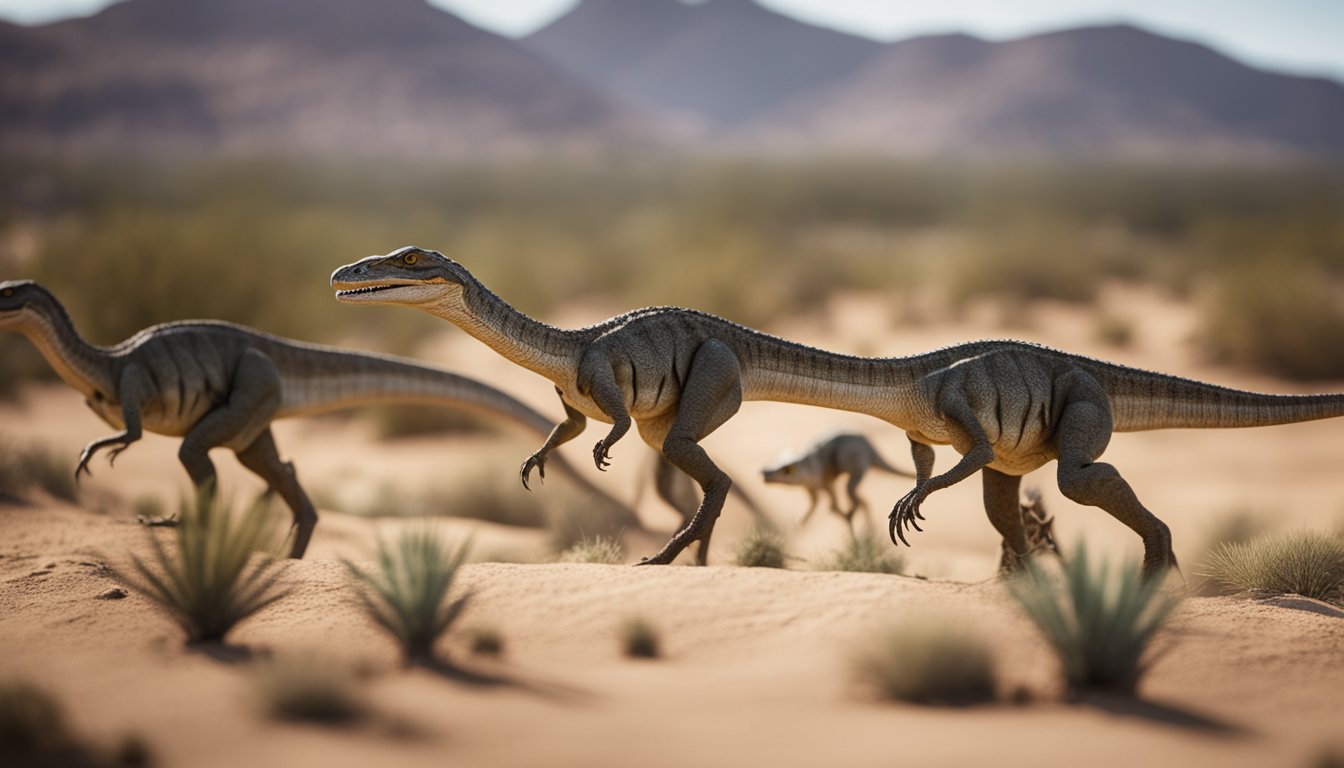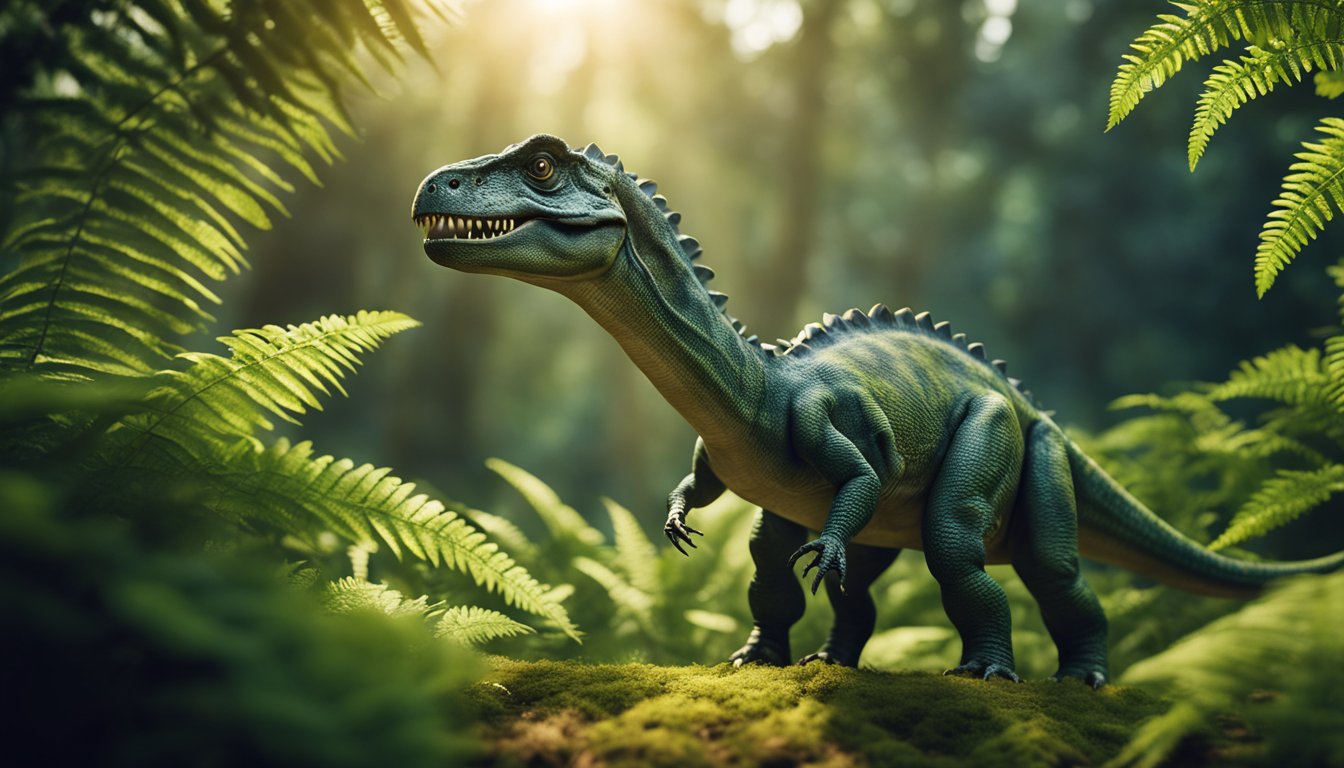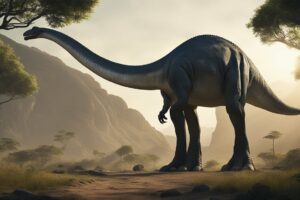Coelophysis is a fascinating dinosaur that roamed the earth during the Late Triassic period, 225-190 million years ago.
What makes this dinosaur unique is the fact that it lived in packs, a behavior that was not commonly seen among other dinosaurs during that time.
Scientists believe that Coelophysis lived in large groups, possibly for protection or to hunt more efficiently.

Coelophysis was a small theropod dinosaur, measuring up to 2.0 meters in length and weighing around 27kg.
Its diet was primarily carnivorous, and it had small, sharp teeth that were used to catch and eat vertebrates.
Coelophysis was also a fast runner, and it moved around on two legs.
These characteristics made it an agile predator that was well adapted to its environment.
Despite being extinct for millions of years, Coelophysis continues to fascinate scientists and dinosaur enthusiasts alike.
Its unique behavior of living in packs has provided valuable insights into the social behavior of dinosaurs and how they interacted with each other.
In the following sections, we will explore the fascinating world of Coelophysis and learn more about this incredible dinosaur that lived in packs.
Unveiling the Coelophysis
The Coelophysis is a small, agile, theropod dinosaur that lived over 200 million years ago during the Late Triassic Period.
It is known for its distinctive features and abilities, such as its hollow bones, which made it lightweight and fast.
In this section, we will explore the fossils and discovery of the Coelophysis, as well as its habitat at Ghost Ranch in New Mexico.
Distinctive Features and Abilities
The Coelophysis had a slender body and long, powerful legs that allowed it to run quickly, making it an excellent hunter.
Its hollow bones were not only lightweight but also provided an efficient respiratory system, allowing it to breathe efficiently while running.
The Coelophysis had a long tail that served as a counterbalance to help it stay balanced while running.
Its sharp teeth and strong jaws made it a formidable predator, capable of taking down prey much larger than itself.
Fossils and Discovery
The first Coelophysis skeletons were discovered in 1881 by Edward Drinker Cope, an American paleontologist.
Since then, hundreds of Coelophysis fossils have been found, making it one of the most well-known dinosaurs of the Triassic Period.
Most of the fossils were discovered in the Ghost Ranch area of New Mexico, where the Coelophysis lived in packs.
Coelophysis Habitat: Exploring Ghost Ranch
Ghost Ranch is a beautiful area in New Mexico that was once home to the Coelophysis. It is a desert landscape with red rocks and stunning sunsets.
The Coelophysis lived in this area in large packs, hunting for food and raising their young.
Today, visitors can explore the same area and see firsthand where the Coelophysis once lived.
Fun Fact: The Coelophysis is one of the few dinosaurs known to have lived in packs, making it a fascinating subject for paleontologists to study.
Social Behavior and Lifestyle

Coelophysis, a small and agile meat-eating dinosaur, lived in packs during the Late Triassic period, around 225-190 million years ago.
These packs were composed of individuals of different ages and sizes, ranging from juveniles to adults.
The social behavior of Coelophysis is a fascinating subject of study for paleontologists, as it provides insights into the lifestyle of these ancient creatures.
Hunting Tactics and Diet
Being carnivorous, Coelophysis relied on meat for sustenance.
They hunted small prey, such as lizards and other small dinosaurs, using their sharp teeth and claws.
Coelophysis was a skilled hunter, and their pack hunting tactics allowed them to take down larger prey than they could individually.
They would surround their prey, using their speed and agility to outmaneuver it, before delivering the deadly bite.
The Pack Dynamics
Coelophysis packs were composed of individuals of different ages and sizes, ranging from juveniles to adults.
These packs were hierarchical, with the older and larger individuals taking the lead.
The pack dynamics were essential for their survival, as they hunted in groups and protected each other from predators.
The social behavior of Coelophysis was not only for survival, but it also allowed for the exchange of information and social learning.
Myths of Cannibalism?
There have been myths surrounding Coelophysis and cannibalism, but recent studies have debunked these claims.
Paleontologists from the American Museum of Natural History have overturned a 1950s claim that Coelophysis was a cannibal that ate juveniles of its kind.
The new research suggests that Coelophysis was not a cannibal, and the previous claims were due to misinterpretation of the fossils.
In conclusion, Coelophysis was a fascinating dinosaur that lived in packs and relied on social behavior for survival.
Their hunting tactics and pack dynamics allowed them to thrive during their time on Earth.
Despite the myths surrounding their behavior, recent studies have shed light on their true nature.
The Coelophysis Legacy

Evolutionary Significance
Coelophysis is a genus of basal theropod dinosaur that lived during the Late Triassic period, approximately 215 to 208.5 million years ago, making it one of the earliest known dinosaurs.
It is also one of the most well-known dinosaurs, due to its abundance of fossils found in New Mexico, Arizona, and Zimbabwe.
Coelophysis is also the state fossil of New Mexico.
The discovery of Coelophysis fossils has been of great importance to paleontologists, as it has provided a wealth of information about the evolution of dinosaurs.
Coelophysis is one of the most primitive theropod dinosaurs, and its anatomy provides a link between earlier carnivorous dinosaurs and later, more advanced theropods like Tyrannosaurus rex.
Coelophysis in Popular Culture
Coelophysis has also made its mark in popular culture, appearing in many books, movies, and TV shows.
In the book “Jurassic Park” by Michael Crichton, Coelophysis is depicted as a small, fast-moving dinosaur that lived in packs.
This depiction of Coelophysis has been popularized in many other works of fiction, and it has become widely accepted that Coelophysis did indeed live in groups.
Coelophysis has also been featured in many educational materials, such as the Dorling Kindersley book “Dinosaur!” which provides an overview of the dinosaur’s biology and behavior.
The book includes illustrations and photographs of Coelophysis, as well as information about its diet, habitat, and social behavior.
Fun fact: Coelophysis was one of the first dinosaurs to be discovered in North America, and it has since become one of the most well-known dinosaurs in the world.
Frequently Asked Questions

How big was the Coelophysis and how does its size compare to modern animals?
The Coelophysis was a relatively small dinosaur, measuring around 2 meters in length and weighing approximately 27 kilograms.
Compared to modern animals, it was about the size of a large dog or a small deer.
What did Coelophysis typically eat during its time on Earth?
Coelophysis was a carnivorous dinosaur, which means that it ate meat.
Its diet consisted mainly of small vertebrates, such as lizards and other small dinosaurs.
Its teeth were small and sharp, which allowed it to easily catch and kill its prey.
Can you tell me about the habitat where Coelophysis roamed?
Coelophysis lived during the Late Triassic period, which was around 225-190 million years ago.
During this time, the climate was warm and dry, and much of the land was covered in deserts.
Coelophysis lived in what is now the southwestern United States, as well as parts of South Africa and Zimbabwe.
How fast could a Coelophysis run, and what advantages did this give it?
Coelophysis was a fast and agile dinosaur, capable of running at speeds of up to 12 miles per hour.
This speed allowed it to quickly catch and kill its prey, as well as avoid predators.
Its long, slender legs and lightweight body made it well-suited for running and jumping.
When did the Coelophysis become extinct, and what might have caused it?
The Coelophysis became extinct around 200 million years ago, at the end of the Triassic period.
The exact cause of its extinction is not known, but it is believed to have been due to a combination of factors, including changes in the climate and competition from other species.
Is there evidence to support that Coelophysis hunted together in groups?
Yes, there is evidence to suggest that Coelophysis hunted in groups.
Fossilized remains of Coelophysis have been found in large groups, suggesting that they lived and hunted together.
This type of behavior is known as pack hunting, and it is still observed in many modern-day carnivorous animals, such as wolves and lions.






